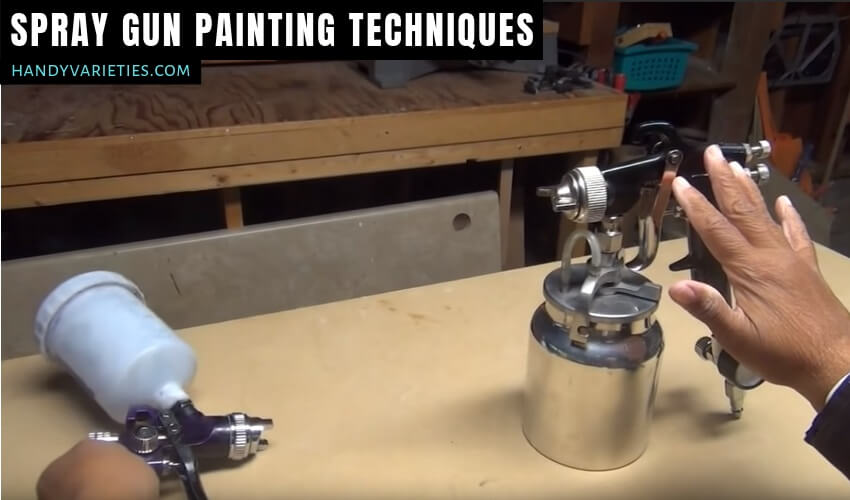Traditionally rollers and brushes have always been trusted, comfortable means for painting, but now the time is for spray guns. You can paint in half the time with professional looking smooth finish only with spray guns. Spraying is the answer to the necessity of modern times by saving time and effort with effective results. A spray gun works great for coating uneven surfaces like door frames and window shutters, and also works great on large flat surfaces. Even though it is really easy to operate spray gun for painting, it is better to know the dos and don’ts of the spray gun painting techniques. You can certainly start working with a spray gun right away, but the more practice and experience, the better the results.
Keeping that in mind, here are some great spray gun painting techniques to assist during your painting projects.
Do Perfect Practice
If it’s your first time painting or just started to do paint jobs, it is wise to practice first before working with a spray gun. Practicing will make you comfortable and confident in your painting techniques and during spraying job you’ll know what to expect.
Choose a large flat surface area as your practice range. Follow the user’s manuals instructions carefully and load the spray gun with water. Then practice your spraying techniques on the practice area. Keep trying different patterns for painting until you are satisfied with the results.
Preparation
Before painting, there’s a need for some preparation first which will lead to a successful paint job.
Checking the Temperature
The ideal temperature for spraying is between 45-75 degrees. Too cold weather will clog the paint inside the gun, and too hot weather will dry the paint too quickly and the surface will not have soaked the paint well. The best painting season is between spring and summer.
Covering Painting Area
To avoid making a big mess, cover the surrounding area and furniture where you will be painting. Use drop cloths, plastics sheets, painter’s tapes or paper to protect floors. Windows and trim. There will be less chance of accidents if you can remove all the furniture and objects from the painting area.
Wearing Protective Gear
Always wear gloves, masks and safety glasses during painting. It’s even better to wear a respirator to protect yourself from harmful fumes and paint particles.
Mixing the Paint
The paint should be mixed well to prevent clogging while spraying. Different types of paint require different approaches to the thinning process, even though normally you can thin most paints with water. However, oil-based paints need to be thinned with mineral based thinning solution. If you have confusion, consult the user’s manual for guidance.
Important Painting Techniques
- To get an even coat, always hold the spray gun in motion with long straight strokes. Start moving the gun before pulling the trigger and continue your stroke after releasing the trigger.
- Hold your arm straight to keep a uniform distance between 8-12 inches from the nozzle to the surface. Maintain the spray gun at right angles to the surface panel so that there’s no heavy spray on one side and overspray on the other end. Avoid tilting the gun upward or downward, rather move the gun side to side in a straight line.
- The overlap between strokes should be about 50% which ensures an even amount of paint on the surface. To achieve the proper overlap, the center of the spray pattern should be aimed at the edge of the previous stroke. When spraying on broad open surfaces, it’s better to spray the outside edges first, then the middle.
- To achieve the spray pattern you want, test and adjust the spray equipment. If the pattern is too narrow, too much paint will be applied to the surface and runs. But if the pattern is too wide, there will be a gap area needing coverage. Look for light spots or missed areas and make sure to touch up with brushes or rollers.
- Do the corners first and finish later the large flat surfaces. To properly spray inside corners such as where two walls meet, aim the spray gun directly into the corner and spray evenly and in one pass.
- While spraying, only work within the area you can easily reach by holding your gun position steady. Don’t angle the tip at the end of your reach to spray further, rather move your whole body.
- Paint buildup at the tip may affect the spray pattern, so clean the paint sprayer and tips between each application with a rag soaked with paint thinner or another solvent. But never use your fingers unprotected to clean tips, that way you can inject yourself with paint.
- Apply multiple thin coats of paint, instead of one or two thick coats for the best finish. Some use back brushing or back-rolling, which is, brushing or rolling in the sprayed on finish to get a more even coat and better penetration. It’s better to back brush stain applications on unfinished or previously stained wood and highly recommended while applying primers as well.
Cleaning
To ensure the longevity and functionality of the spray gun, it is crucial to clean the device every time you use it. Empty the paint container, fill it with water or paint thinner and then flush it through your paint sprayer container until it runs clear. Use water to clean for water-based paints like latex and use paint thinner to clean oil-based paints like lacquer. Then take apart the whole gun, tips and filters and soak them in the solution. Gently rub the parts with a rag or brush to remove the extra paint, dirt, grime stuck there. Make sure to fully dry the parts and then reassemble.
Conclusion
So, these are the basic, most common techniques for spray gun painting. It may seem intimidating with preparation, painting and cleaning all put together, but trust that it is actually pretty easy and simple to follow the steps. And if you have doubts, just follow the user’s manual instructions.
Your painting session doesn’t have to be a bore and a chore! Use these spray gun painting techniques and make it an easy and pleasant experience to remember.
Related Posts:

